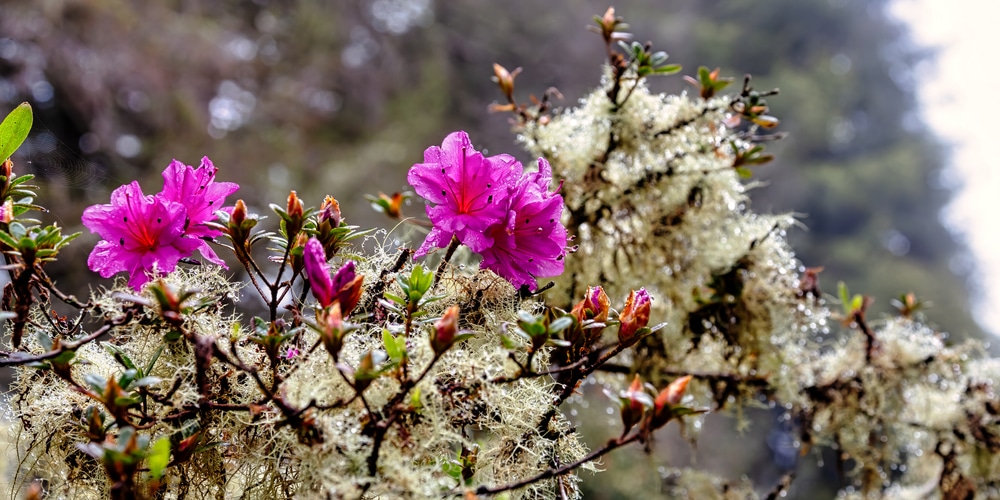Early spring is a beautiful time of year. The trees and shrubs are starting to bloom, and the world is coming back to life after a long winter. For gardeners, it’s a time of hope and possibility.But sometimes, that hope is dashed by the sight of unsightly lichen on azaleas and other shrubs.
Considered by many as the queens of the spring season, azaleas (Rhododendron sp.) are prized for their showy flowers and compact growth habit.
When lichen invades, however, it can mar their beauty and cause concern among gardeners.
What are Lichens?
Lichen is an organism that, despite appearing to be a single unit, consists of a fungus and alga living together in a symbiotic relationship. In that relationship, algae provide food via photosynthesis while the fungi supply moisture.
Do they harm azaleas?
The uniqueness of these organisms does not end at being a combination of fungi and algae. They are also “air plants”, seeing as they never tap into the vascular system of the plants that they attach themselves to. It is for this reason that lichens don’t actually harm the plants that they live on.
In truth, lichens will grow on healthy plants and unhealthy ones as well. So next time you see lichens on sickly azaleas, don’t put the blame on them.
If you look around the landscape, you might even see the lichens growing on inanimate objects such as fence posts or rocks. That should be proof enough that lichens don’t need a plant’s vascular system to get nutrients.
It goes without saying, nonetheless, that lichens will detract your azaleas from their beauty.
What conditions favor the prosperity of lichens need to thrive?
There are various conditions that favor the thriving of lichens as discussed below:
1. Non-moving objects
So as to anchor themselves and not risk being blown away or waterlogged, lichens need a nonmoving object to attach themselves on. This is the reason you see them so often on trees and shrubs.
2. Aging plants
A plant that has reached its growth peak is home-sweet-home for lichens. That’s in consideration that the stem diameter and length are not increasing constantly. As such, lichens can establish and thrive easily.
3. Plants that lose leaves or branches
The two most important growth requirements for lichens are enough sunlight and moisture. That’s why you’d often find these organisms in sunny spots that are easily accessed by rainwater or moisture.
If, therefore, your azaleas have a sudden and significant loss of leaves and branches, they’d be creating a favorable condition for lichens to grow.
Even though lichens are basically not harming your azaleas, they may be pointing to dying or unhealthy plants.
Should you remove lichens from azaleas?
One thing that you should keep in mind is that it’s not really beneficial to remove lichens from azaleas. If anything, trying to remove lichens can do more harm than good.
That’s in consideration that you might end up injuring the bark of your azaleas while trying to remove the lichen, which can provide portals for pests and diseases.
If, however, the look of the lichen disgusts you, there are some actions that you can take.
How to remove lichens from azaleas
There are three main methods of removing lichens from azaleas:
1. Creating shade
One of the most effective ways to get rid of lichens is to encourage healthy growth to create a canopy shade. But before that, you would have to create shade on the affected parts of the plant, so that these organisms can die on their own.
To do that, you can use a shade cloth and fit it onto the affected branches.
You may have to tie the shade cloth down using a little bit of string. After some time, the lichens will start dying since one of the basic growing requirements is not being met.
2. Rubbing off the lichens
A quicker method that puts the well-being of your plants’ barks at risk is rubbing off the lichens after moistening them with water.
To do that, you’d have to moisten the affected area using water or wait for rain. After the lichens have soaked for quite a while, use a soft scrubbing brush – maybe even a soft-bristle toothbrush – or a pad to rub the affected areas.
You may have to empty your bucket or container that has water quite often so as to refill it with clean water as required.
3. Spraying with an organic fungicide
Using organic fungicides, such as one that contains copper or sulfur should kill the lichens without harming your azaleas.
Best way to deal with lichens?
Azaleas are, hands-down, the unwelcome guests in most gardens. But what’s the best way to deal with them?
The best way to handle lichens is to prevent them from existing, in the first place. That you can do by correcting the conditions that result in poor growth and development of your plants.
Make sure that your azaleas have enough nutrition to encourage healthy growth by fertilizing them. In addition, you will want to ensure that you plant your azaleas in high-quality, well-drained soils.
You may also have to water and prune your plants when necessary since the main goal is to keep them healthy. That way, they will have a bushier growth and a good canopy that shades the branches sufficiently.
Related Article: Are Azaleas Cold Hardy?

